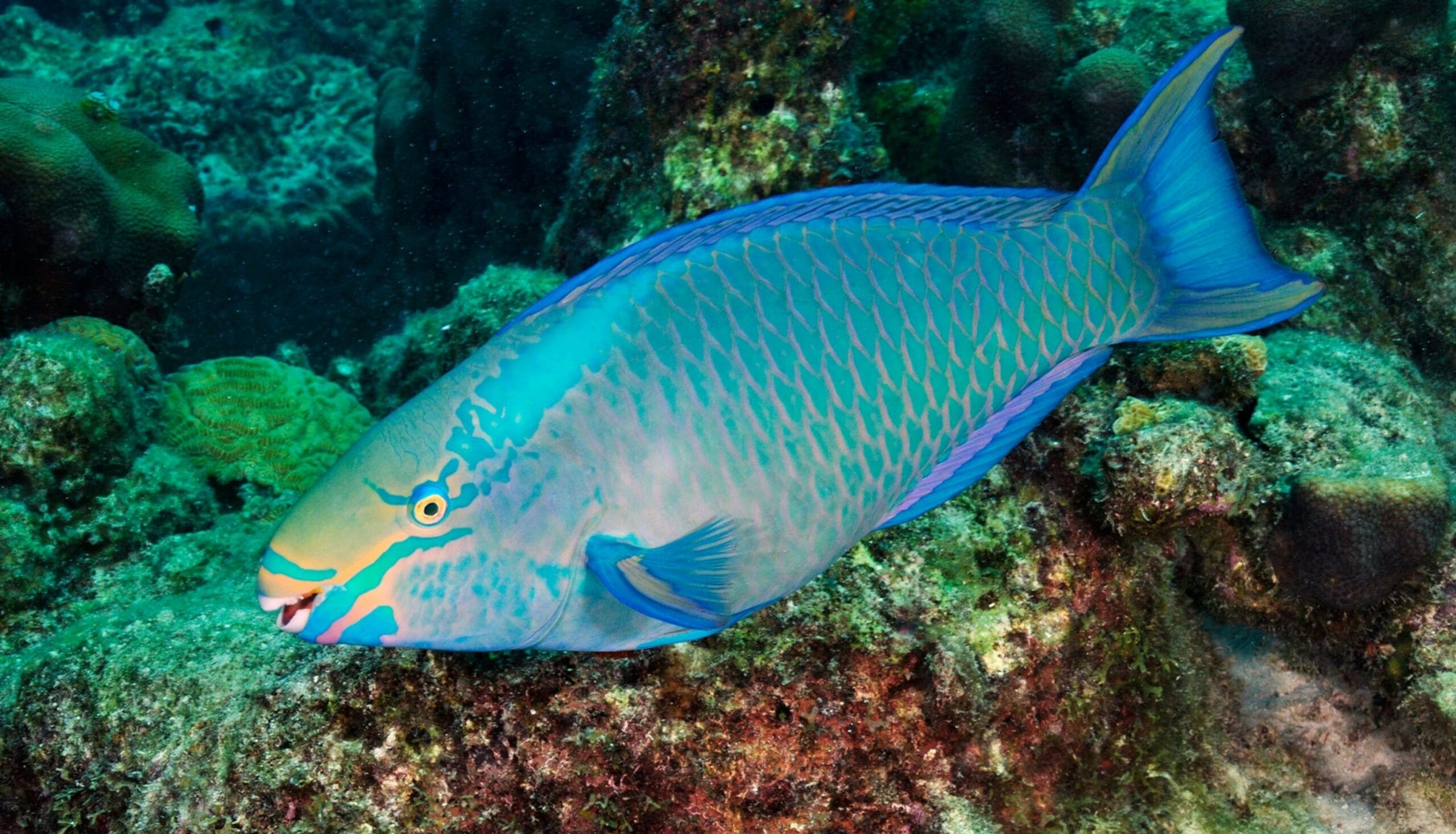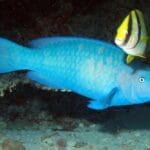Get ready to dive into the dazzling world of rainbow parrotfish, the vibrant guardians of our coral reefs. We’ll explore their underwater homes, uncover how they earned their rainbow colors, and discover why their algae munching habits are essential to reef health. Let’s plunge into the secrets of these fascinating creatures that keep our oceans thriving.
From Drab to Dazzling: The Rainbow Parrotfish’s Transformation
The rainbow parrotfish (Scarus guacamaia) is a spectacle of nature, boasting a kaleidoscope of colors that could rival any rainbow. These underwater jewels, however, aren’t born this way. Juvenile rainbow parrotfish are remarkably drab, blending seamlessly with their surroundings. This camouflage likely helps them evade predators while they mature.
As they grow, a dramatic transformation unfolds. Males, in particular, develop a stunning array of colors, a spectacle that signals their maturity and plays a crucial role in attracting mates. Their scales shimmer with vibrant blues, greens, yellows, and oranges, making them one of the most recognizable and breathtaking inhabitants of the reef.
More Than Just a Pretty Face: The Parrotfish’s Vital Role
Beyond their captivating appearance, rainbow parrotfish are essential to the health and balance of coral reef ecosystems. They are considered keystone species, meaning their presence profoundly influences the entire community.
The Reef’s Landscapers: Algae Control
Rainbow parrotfish are herbivores, and their diet primarily consists of algae. While this might sound mundane, their feeding behavior is crucial for reef health. Algae, if left unchecked, can smother corals, preventing them from receiving sunlight and thriving. By grazing on algae, rainbow parrotfish act as the “gardeners” of the reef, ensuring corals have space and resources to flourish.
Sand Sculptors: An Unexpected Contribution
Believe it or not, these vibrant fish play a significant role in creating those pristine white sandy beaches we associate with tropical paradises. As they graze on algae, rainbow parrotfish also ingest coral fragments. Their specialized pharyngeal jaws, located in their throats, grind up these fragments into fine sand, which is then excreted. A single rainbow parrotfish can produce hundreds of pounds of sand each year!
Sleeping Tight: The Mucus Bubble’s Protective Embrace
When it’s time to rest, rainbow parrotfish exhibit a peculiar behavior. They secrete a protective cocoon of mucus around themselves, essentially tucking themselves into their own sleeping bags. This mucus bubble serves several purposes. It masks their scent from predators, deters parasites, and creates a physical barrier against nocturnal threats. This ingenious adaptation highlights the remarkable lengths to which creatures go to survive in the often-harsh environment of the coral reef.
Girl Power to Boy Power: A Gender-Bending Life Cycle
One of the most fascinating aspects of rainbow parrotfish biology is their reproductive strategy. They are sequential hermaphrodites, meaning they can change sex during their lifetime. Most rainbow parrotfish begin their lives as females. As they mature, some females will transition into males, often triggered by social cues or changes within their social group. This flexibility in their reproductive roles helps maintain a healthy balance of males and females within parrotfish populations.
A Reef in Peril: Protecting Our Colorful Friends
While rainbow parrotfish are not currently classified as endangered, they face mounting threats. Overfishing, habitat destruction, and climate change are all taking a toll on their populations and the delicate ecosystems they call home.
Overfishing: A Looming Threat
In some regions, rainbow parrotfish are targeted for food, particularly in areas where other fish stocks have been depleted. Overfishing can disrupt the delicate balance of reef ecosystems, as the removal of these herbivores can lead to unchecked algae growth and coral decline.
Habitat Destruction: A Home Under Pressure
Coral reefs, the very foundation of the rainbow parrotfish’s existence, are facing unprecedented threats. Climate change-induced coral bleaching, pollution, and destructive fishing practices all contribute to habitat degradation. As coral reefs suffer, so do the countless species that depend on them, including the rainbow parrotfish.
Climate Change: A Global Challenge
Rising ocean temperatures and ocean acidification, both driven by climate change, pose significant challenges for rainbow parrotfish and coral reefs worldwide. Warmer waters stress corals, making them more susceptible to bleaching, while ocean acidification makes it harder for corals to build their calcium carbonate skeletons.
Be a Reef Ranger: You Can Make a Difference!
The fate of the rainbow parrotfish and their coral homes rests not solely on scientists and conservationists but on each of us. Our collective actions can make a world of difference.
Sustainable Seafood: Choosing Wisely
One of the most impactful steps we can take is to make responsible seafood choices. Look for sustainably sourced seafood certified by organizations like the Marine Stewardship Council (MSC) or the Aquaculture Stewardship Council (ASC). These certifications help ensure that fish are caught or farmed in a way that minimizes environmental impact and supports healthy fish populations.
Supporting Conservation Efforts: Joining the Fight
Numerous organizations are dedicated to protecting coral reefs and the species that call them home. By donating our time or resources, we can empower these organizations to continue their vital work in research, conservation, and education.
Spreading Awareness: Knowledge is Power
Perhaps one of the most straightforward yet impactful actions we can take is to spread awareness about the importance of rainbow parrotfish and the challenges they face. By engaging in conversations with friends, family, sharing information online, or simply talking about these fascinating creatures, we can help inspire others to care and take action.
Where are rainbow parrotfish found?
These underwater jewels are found in the warm, crystal-clear waters of the Western Atlantic Ocean. Their range extends from Bermuda and South Florida all the way down to Venezuela, encompassing the Caribbean Sea and its islands, including the Bahamas.
They particularly thrive in shallow waters around coral reefs and mangroves, where sunlight filters through the water, providing ideal conditions for algae growth. These habitats offer a perfect combination of food and shelter for these colorful grazers.
How to Get Rainbow Parrotfish?
Bringing a rainbow parrotfish into your home aquarium is not recommended. These fish require highly specialized care and a precisely controlled environment that mimics their natural habitat. Additionally, their removal from the wild can have detrimental effects on reef ecosystems.
However, if you’re looking for a virtual encounter, you can find rainbow parrotfish in games like Roblox Fishing Simulator. Here’s how to reel one in:
1. Level Up Your Game: Reach at least level 15 to unlock the necessary gear and fishing locations.
2. Cash Rules Everything: Make sure you have enough in-game currency for high-quality fishing equipment.
3. Set Sail for the Archipelago: Head to the Ocean of Jackson Archipelago, a prime spot to find rainbow parrotfish.
4. Sunny Skies and Good Vibes: Find a sunny spot, as these fish are more active in bright conditions.
5. Patience, Young Fish Whisperer: Cast your line and exercise patience; it might take a few tries to hook this prized fish.
Are Rainbow Parrotfish Herbivores?
While rainbow parrotfish are primarily herbivorous, they display a degree of dietary flexibility.
Algae: The Main Course:
Their diet mainly comprises algae, which they scrape off rocks and coral using their fused, beak-like teeth. This grazing behavior is essential for preventing algae overgrowth and promoting coral health.
Occasional Omnivory:
While algae form the foundation of their diet, rainbow parrotfish may occasionally consume small invertebrates, microorganisms, or even nibble on coral polyps. This opportunistic feeding behavior contributes to the overall balance of the reef ecosystem.
Exploring the Rainbow: A Call to Action
The rainbow parrotfish, with its dazzling colors, quirky behaviors, and vital ecological role, stands as a testament to the beauty and complexity of coral reef ecosystems. By understanding their importance and the threats they face, we can all become stewards of these vibrant underwater worlds and ensure that future generations can marvel at the brilliance of the rainbow parrotfish.
Remember, every action, no matter how small, can create a ripple effect. By supporting sustainable practices, spreading awareness, and advocating for change, we can help ensure that these jewels of the reef continue to grace our oceans for years to come.
















